Four amazing Stone Age sites with wooden artifacts
From Africa, Asia, and Europe, these sites give us a rare window into the ways that organic technology shaped ancestral lives.
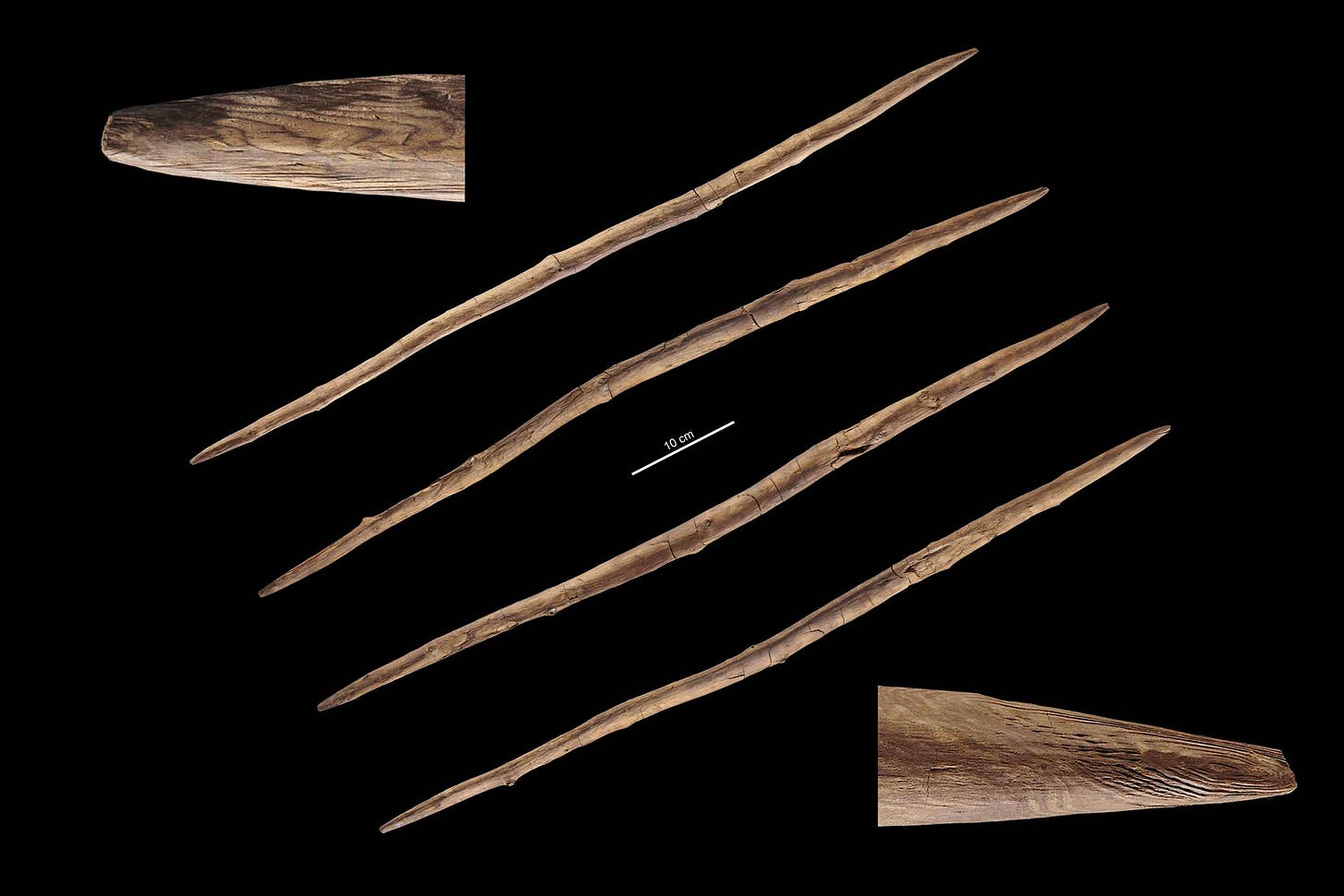
The word technology today brings to mind silicon wafers and steel. But for most of human existence people have relied on organic materials for most of their technology. People wear clothing made from hides, wool, and plant fibers; they twine string, weave baskets, and make floor mats and bedding from plants. They knit with wooden needles, weave with wooden looms, and fish with wooden poles and plant fiber nets. Weapons and implements have been made from wood since time immemorial. Only when the task requires something uniquely hard, or a sharp edge that resists quick wear, did people resort to stone—or later, pottery, metal, and glass.
The Stone Age got its name for a reason, but it's not because people only used stone. Time has decayed the organic richness of ancient cultures and left only the durable flakes of rock for archaeologists to find. With little else to examine, archaeologists classify the peoples before the dawn of metallurgy only by the patterns of these stone artifacts. Their view of technology in ancient lives is thereby impoverished.
Yet there are places where natural conditions have preserved wooden artifacts across millennia. Most of these sites are recent in geological terms, dating to the last 20,000 years or so. As a paleoanthropologist I am more interested in much older sites that represent our more ancient ancestors and relatives. Fortunately there are some that go back hundreds of thousands of years. Here are four that add a deep perspective to organic technology made by our ancestors.
Schöningen, Germany
The most well-known archaeological site with ancient wood is Schöningen, in central Germany. At the edge of a lake 200,000 years ago, people hunted horses and left behind the butchered horse bones, stone tools, and many wooden spears, throwing sticks, and other artifacts. The lake underwent a succession of further sedimentation and buildup of organic material, burying the shoreline and its tools.
Fast-forward to the twentieth century, when the organic deposits were mined in a huge open-pit operation. The so-called “spear horizon”, designated as Schöningen 13 II-4, is a surface upon which ten or more spears have been identified across a space of some fifty meters, along with many other wooden artifacts. This is only one of many archaeological finds from Schöningen, and other levels also have preserved ancient wood artifacts.
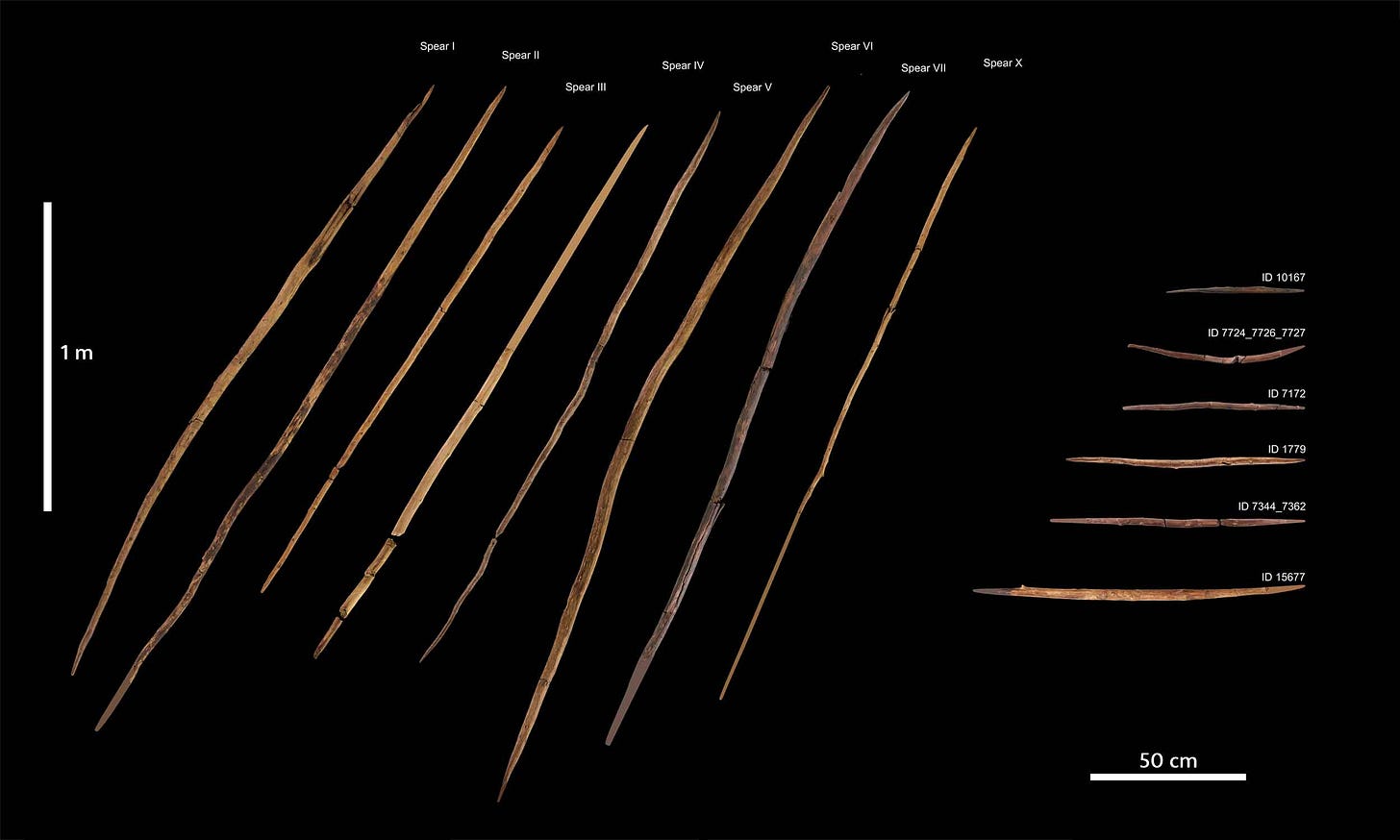
While the site has long been known for the spears, other categories of artifacts have recently gotten more focus. Last year, Annemieke Milks and collaborators described the manufacture and function of a shorter stick with points on both ends, termed a “double-pointed stick”. Hunters in some historic foraging societies used similar sticks to throw at game animals, boomerang-like, sometimes stunning or injuring the animals and other times tripping up their escape. In contrast to the longer spears which might take on some of the biggest prey animals, these throwing sticks were useful in pursuit of some smaller prey.
In 2024, Dirk Leder and coworkers reported some remarkable new observations on 187 wooden artifacts from the spear horizon. In addition to the weapons, they brought attention to small wooden tools used for domestic tasks like smoothing hides or punching holes. Bone tools with similar functions are known from some later sites, but almost certainly wood was much more commonly used for these purposes without leaving any archaeological trace. The researchers provided details of split-wood manufacture of some artifacts, sharpening and signs of use wear, and fire-hardening. They showed how some of the spear points were resharpened after earlier breakage or dulling, and they documented that wood implements must have been transported over some distance to where they were finally abandoned. These are quite obviously the tip of an unseen iceberg of technology.
Poggetti Vecchi, Italy
Poggetti Vecchi, Italy, is a site with thermal pools that preserve evidence of straight-tusked elephants and other animals from around 170,000 years ago. Archaeologists have uncovered least 39 wooden tools, many of them interpreted as digging sticks. Many of them were described in 2018 in an article led by Biancamaria Aranguren.
All the artifacts identified at Poggetti Vecchi were made from boxwood, Buxus sempervirens. Aranguren and coworkers considered why boxwood was so preferred by the ancient people who made these wooden tools, and they found that the wood is harder, denser, and more resistant to breaking than other species that were present in the ancient environment. Many of the artifacts had charred surfaces, patterned around the circumference in a way that hardened the wood. Some have a clearly rounded end forming a handle that the user could apply pressure to the pointed, working end of the stick.

The researchers did some experiments to identify the techniques that the ancient people had used to shape these sticks. Key tools in the process were abrasive stones, which were used for shaping the rounded handle, sharpening the point, and removing the bark. In essence, the sticks were filed into shape, after applying fire to the outside to harden the wood and make the bark easier to remove.
Kalambo Falls, Zambia
The Kalambo River forms part of the border between Zambia and Tanzania, and just upstream of where it enters Lake Tanganyika is the impressively tall Kalambo Falls. The river in the basin just above the waterfall is slow-moving and winding, with margins that have shifted over time. Downcutting of the banks has exposed archaeological deposits from the former river margins, first excavated by the archaeologist J. Desmond Clark in the 1950s. Clark uncovered a long sequence of hominin activity, including many of the stone tool industries recognized across Africa. Among the stone artifacts were pieces of preserved wood, including a few that Clark recognized as implements.
Last year, Lawrence Barham and collaborators reported an unexpected discovery from their recent work at Kalambo Falls. Opening new excavations into the riverbank deposits, they uncovered many wood artifacts. These include an apparent digging stick, logs that were cut by stone blades, and a remarkable pair of logs that had been notched to fit one over the other. Barham and coworkers are not sure what the function of the notched log structure may have been, but they speculate that it may have served as the foundation of a hut or shelter, or it may have served as a platform or part of a walkway, or even as a workbench. What is clear is that ancient hominins applied patterned effort to shape the logs and build with them. This structure is around 476,000 years old.

In their paper, Barham and colleagues point back to the work by Clark, who also described a wood log, split on one end, with a shaped groove or notch cut into it. Clark had been cautious due to the evidence of water action possibly shaping some of the wood pieces, but emphasized that some “flat, board-like pieces of wood” were present that seemed to have been shaped intentionally, as well as pointed and possibly fire-hardened sticks that were likely digging sticks. The recurrence of similar discoveries more than sixty years later shows that there may be many more to discover at Kalambo Falls.
Gantangqing, China
One of the newest discoveries of ancient wooden artifacts is in southwestern China, south of the city of Kunming. In a terrace above the Gantangqing stream, Xing Gao and collaborators worked from 2015 to 2019 to excavate a large area exposing levels of ancient lakeshore between 361,000 and 250,000 years old. The excavations revealed stone artifacts, remains of varied plants and pollen, and 35 wooden tools.
The tools include two digging sticks around a half meter in length, as well as many smaller artifacts. The researchers suggest that many of the smaller pointed tools may also have been used for digging, probing into the earth for edible plant parts, and digging grubs. In addition to the wooden tools, the excavations revealed several pieces of antler that were used as retouchers for stone flaking. Stone artifacts are very numerous with more than 3000 across the excavation, and Gao and coworkers report that all of these must have been carried for at least 5 km from the nearest sources.
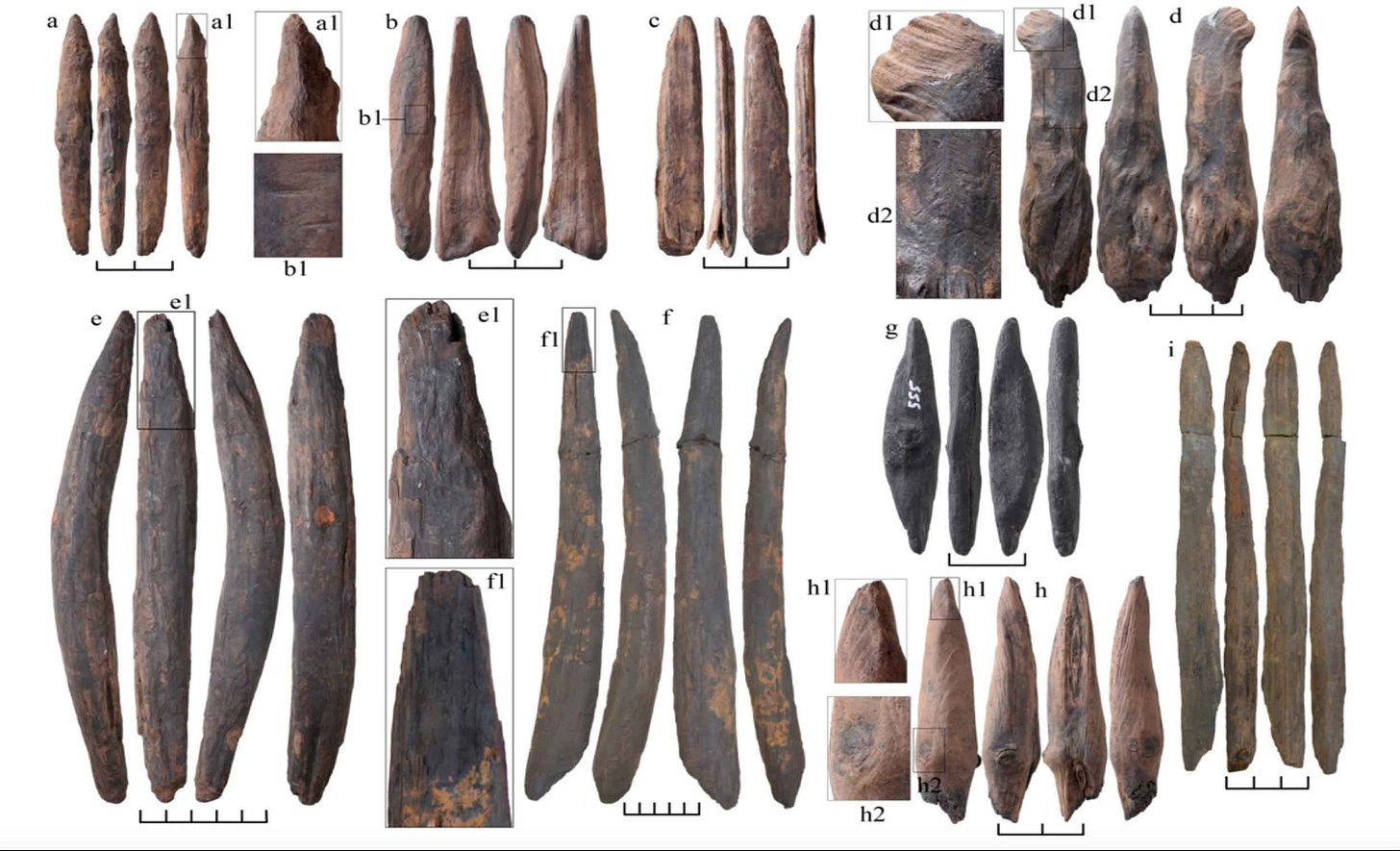
One of the most exciting aspects of Gantangqing is the preservation of starch grains on the tips of some of the wooden artifacts. These include starch residue from lilies, bulrushes, arrowhead, yams, and taro, all suggesting that the pattern of activity was digging for the edible underground storage organs of plants near a lake or marsh margin.
The preprint describing the Gantangqing results was posted by Gao and coworkers in 2021, and this work has not yet appeared in a journal. A three-year delay between preprint and publication is not unusual—in the last year I've even seen journals celebrating the lengthy period of revision and additional experimentation that happen during their editorial process. I think this trend is awful. In any event, the results described in the preprint mostly speak for themselves as a description of a very important site with evidence of ancient wood artifacts.
A world of wood beyond
Many other sites deserve attention for their preservation of ancient wood. Gesher Benot Ya'aqov, Israel, is an ancient site on the bank of the Jordan River south of the historic Lake Hula. There, excavations have exposed the remains of ancient fires going back around 780,000 years ago, with evidence of cooked plant foods, nuts, and fish. Some wood is also preserved in the sediments, and early work brought to light a piece of a wooden plank with intentional shaping. This currently is the oldest modified wooden artifact in the archaeological record.
Aranbaltza is a floodplain site in northern Spain, with several archaeological localities dating back to between 140,000 and 50,000 years ago. One of these localities is Aranbaltza III, where in 2015 Joseba Rios-Garaizar and coworkers recovered a pointed wooden tool, around 20 cm in length. The evidence of crushing and wear at the pointed end suggested that this stick had been used for digging.
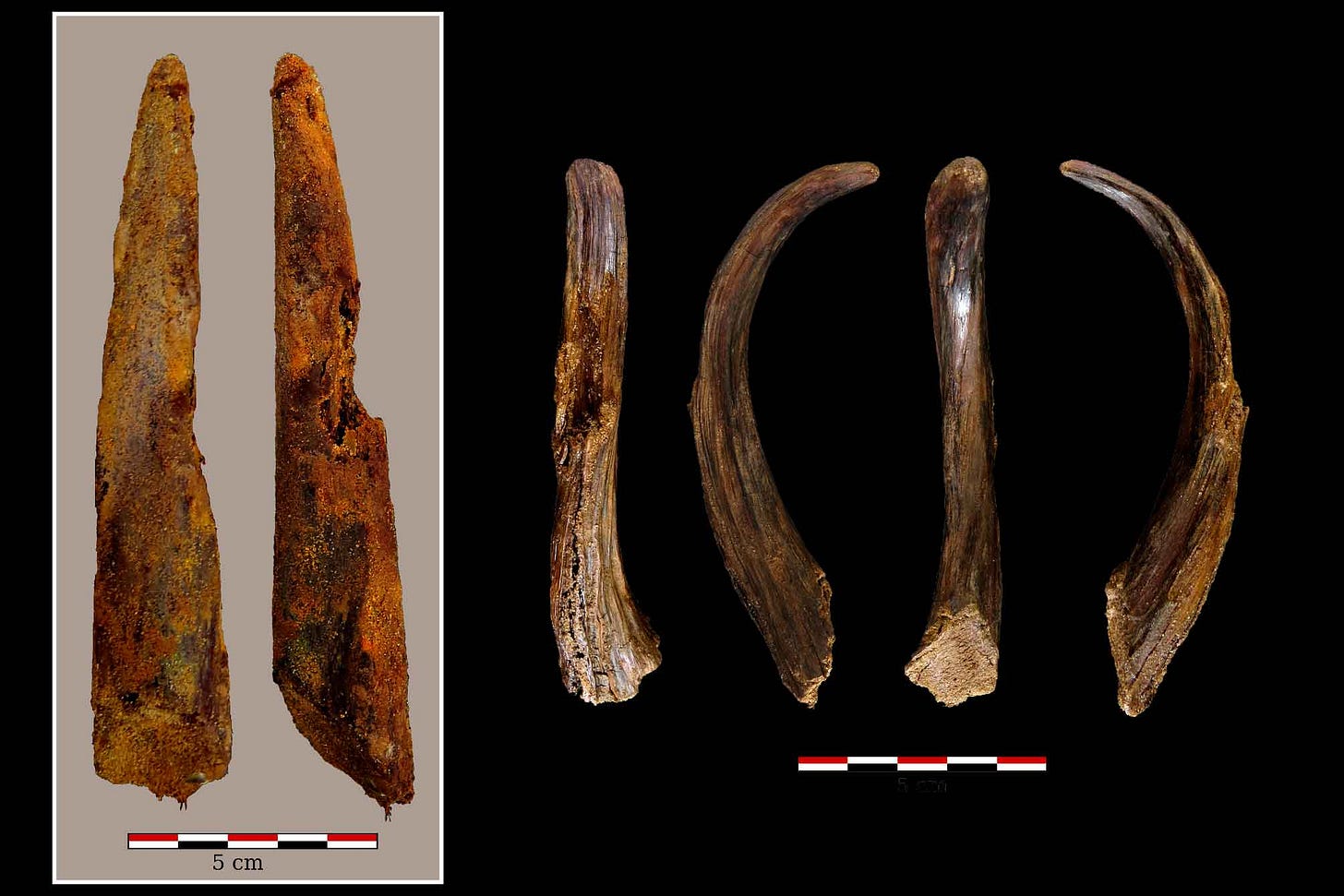
Aside from the exceptional Kalambo Falls finds, one of the earliest wooden artifacts from Africa is from Florisbad, South Africa. That site is a natural spring with peat deposits that can preserve organic materials for a very long time. A number of wooden artifacts were identified during excavation of the springs in the 1930s and thereafter, but these tended to disintegrate quickly after excavation. The anthropologist Kenneth Oakley visited Florisbad and took one wooden artifact to London, where the wood was treated with chemicals similar to those used to preserve artifacts from later waterlogged sites. The artifact was later examined by Desmond Clark, who interpreted it as the broken point of a larger throwing stick. In 2003, Marion Bamford and Zoë Henderson carried out a re-examination of this artifact to provide some modern detail. One of the most interesting aspects was the wood that it is made from: kundanyoka knobwood (Zanthoxylum chalybeum), which today occurs no further south than Zimbabwe. The implication is that a very much warmer climate occurred around Florisbad at the time this tool was made, although the dating and context of the artifact are still uncertain.
The last site I'll mention is one that points to a different kind of preservation of organic artifacts: Instead of direct survival of the organic wood, in a few sites imprints of wood are preserved in sediment or rock that formed around the wood before it decayed. The most well-known of these is Abric Romani, Spain, a rockshelter on the Anoia River in Catalonia. Excavations there starting in the 1980s recovered poorly-preserved wood objects and charred wood, preserved beneath travertine. The travertine in some cases formed around wooden objects which later decayed, resulting in the preservation of a natural imprint of the wooden objects in the travertine. In a few cases both parts of the original wood artifact and the imprint were present. These are found in a succession of layers from around 45,000 years ago back to as early as 75,000 years ago.
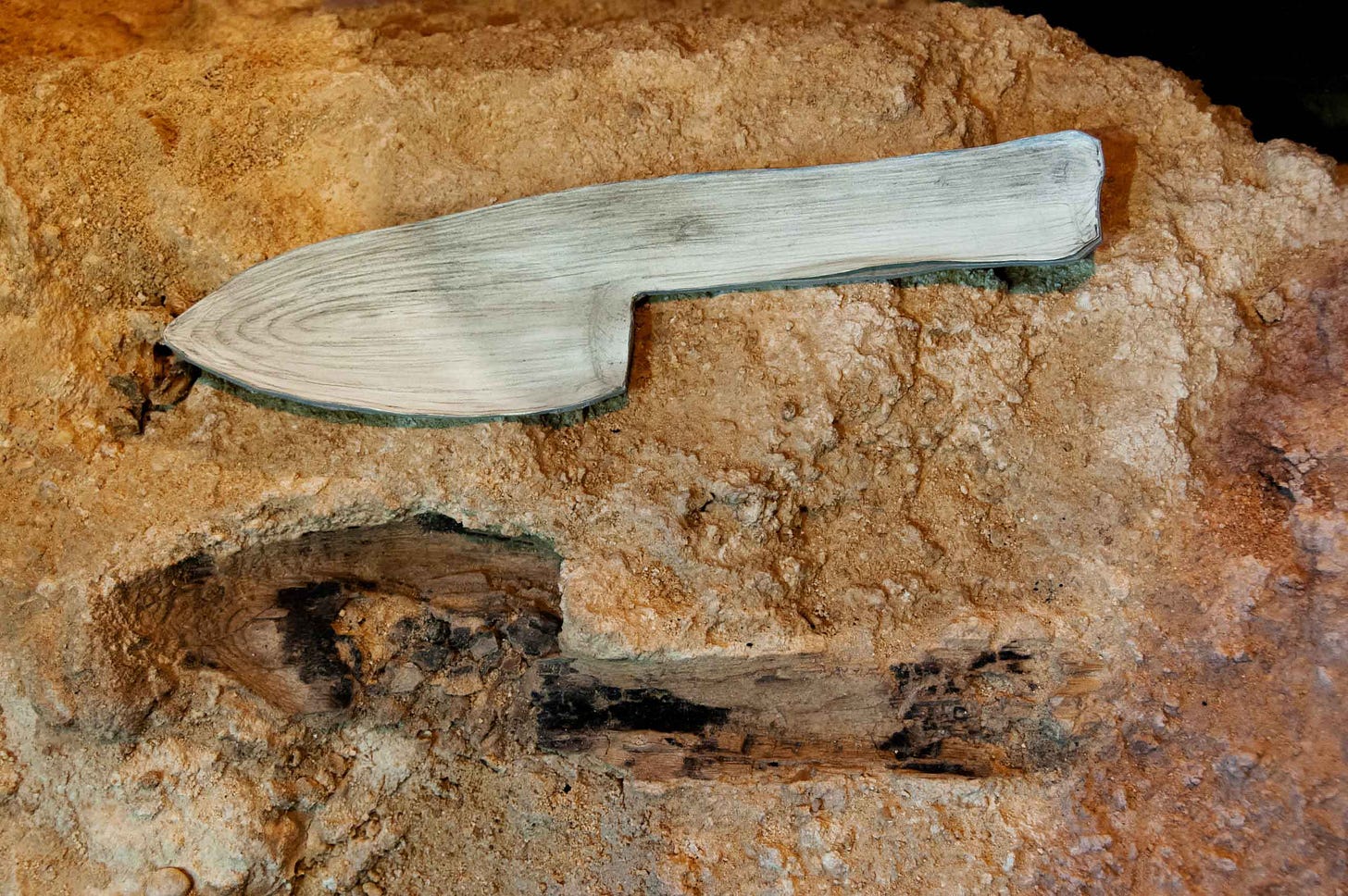
Many of these imprints, which are called wood pseudomorphs are present in the site. Some reflect unmodified wood while others show clear evidence of intentional shaping. One such arrangement of three sticks was interpreted as the remains of a possible tripod. Recent work at the site has been led by Palmira Saladié, including the discovery of a wood imprint representing an artifact with a handle, a much broader flat blade, and pointed end. This “blade” extends from the “handle” by a carved cut of 90 degrees, a shape resulting from deliberate shaping.
This kind of artifact is fascinating. It helps make sense of some of the earlier artifacts that are shaped like flattened planks. Some may have been blanks for further shaping into functional pieces, while others may have been platforms that provided a flat surface for working smaller objects and other materials.
The phylogenetic breadth of wooden technology
The first question I get when I talk about ancient tools of any kind is: “Who made them?” For most of these cases, it's not an easy question to answer. But I don't think the answer is actually very important.
To be sure, at some sites archaeologists presume that the population that left the artifacts was linked to skeletal remains found at other nearby sites. For example, the Abric Romani wooden pseudomorphs and artifacts come from a period when only Neandertal fossil bones have been found at other sites in Iberia. The wood artifacts cover tens of thousands of years through which the Neandertal population of the region was certainly not uniform. Many different cultures in the same area over time must have made them—another argument for their universality among early human cultures. Still, in a broad sense it is fair to say that these artifacts were associated with Neandertals.
At sites like Kalambo Falls no one can claim such an association with any confidence. Several hominin populations existed during the time period around 400,000 years ago in Africa. Anthropologists don't have much evidence about the geographic ranges of these populations, how much they overlapped, or what stone artifacts the varied populations used. The evidence does not reach a level where it makes sense to assert association of tools with a population, even in the broadest sense that they occurred at the same time and geographic region. Again, finding wood artifacts over a long period of time—in this case, maybe hundreds of thousands of years—is a strong argument that many or most hominin cultures must have produced them.
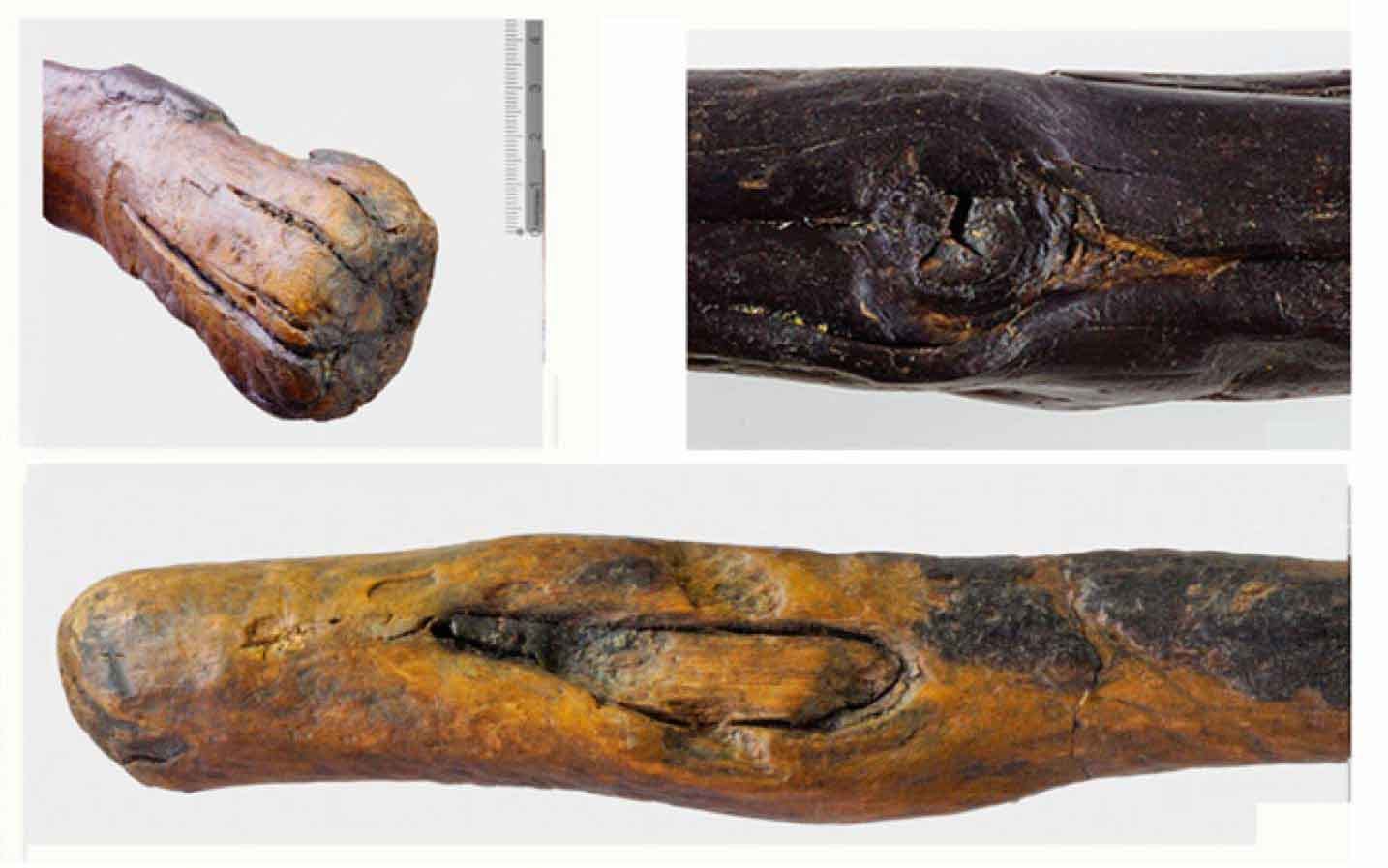
Way earlier than any of these sites, some of the earliest Oldowan stone artifacts bear evidence that their sharp edges were used to shape wood. Many Acheulean handaxes and cleavers were used for wood shaping also. In other words, evidence for woodworking goes back long before any of the lucky sites that have preserved the oldest wood artifacts known so far.
Comparison with other living primates suggests that wood has a greater phylogenetic depth than stone tools in our evolutionary history. Chimpanzee tools are mostly made from wood or other plant materials such as stems and leaf ribs. Some are complex wooden toolkits in which the chimpanzees apply several distinct tools in combination to accomplish tasks like probing honey from underground bee nests. They use dozens of organic tool types, while stones are used only in a couple of situations: some chimpanzee groups use stones to crack nuts (many others use logs instead), and in a few places chimpanzees throw rocks. Our other close living relatives, bonobos, use fewer tools than chimpanzees, every one made from plant materials. While some bonobos have been trained in captivity to make tools from stone, primatologists have not observed them doing so in their natural habitats.
What that means is that the earliest hominins almost certainly used a wide range of wood tools before they routinely flaked stone. Wood came first, stone came later.
Nor can we forget bone as a raw material. Occasionally hominins flaked bone as if it were stone but in most cases, bone probably was an occasional substitute for the hard wood that was more routinely used. Such substitution for wood may be seen with the bone digging tools found with Paranthropus robustus in South Africa and the many bone leather smoothing tools from Neandertal sites.
Every site with preservation of wood artifacts is incredibly valuable as evidence of ancient organic technology, but every one of them is late in the game. Nonetheless, they can tell us a lot about the millions of years of wood technology that preceded them. For one thing, every one of the sites that preserve wood artifacts show a close attention to the type of wood used. To make spears and digging sticks all these hominins selected hard wood that resisted breaking. They often used fire to harden the wood further. Another thing shared by several early sites is the shaping of large logs, including smoothing some pieces into wedges or planks. The function of such artifacts is not entirely obvious, but these pieces show how stone became important to wood construction, enabling hominins to carve notches, shaped pieces, and wedges from wood.
The aspects of planning and intentionality in woodworking demonstrated across these sites was shared across different hominin populations. Their cultures shared these elements despite a separation of hundreds of thousands of years of evolutionary change. Archaeologists sometimes note the incredible conservatism of stone artifact types like the handaxe. The wood technologies evidenced at these sites were maintained or reinvented again and again, not in mindnumbing static form like a handaxe, but in a diversity of different tool forms that are manifested at every one of these sites. The technology of ancestral hominins was dominated by organic materials. A hominin group that lacked a particular method of stone flake manufacture might hardly notice. Indeed, in some contexts the ready availability of organic materials like bamboo may have made stone tools much less valuable for many tasks. By contrast, it is hard to imagine any of their lifestyles without wood.
Notes: This is not a comprehensive list of ancient sites with wood preservation, and I am sure readers all have their favorites. I might mention Clacton-on-Sea in the UK and Lehringen, Germany as places with additional ancient spears, and there are a much wider array of Upper Paleolithic and other sites after 40,000 years ago with some wood preservation. What I love about the most ancient examples is that they inform about the use of organic materials of the deeper common ancestors of the populations that made them.
This post was updated in May, 2025 to recognize a new dating for the Schöningen occurrences of wooden artifact horizons to around 200,000 years ago. The work is from Jarod Hutson and collaborators.
References
Aranguren, B., Revedin, A., Amico, N., Cavulli, F., Giachi, G., Grimaldi, S., Macchioni, N., & Santaniello, F. (2018). Wooden tools and fire technology in the early Neanderthal site of Poggetti Vecchi (Italy). Proceedings of the National Academy of Sciences, 115(9), 2054–2059. https://doi.org/10.1073/pnas.1716068115
Bamford, M. K., & Henderson, Z. L. (2003). A reassessment of the wooden fragment from Florisbad, South Africa. Journal of Archaeological Science, 30(6), 637–650. https://doi.org/10.1016/S0305-4403(02)00245-5
Barham, L., Duller, G. a. T., Candy, I., Scott, C., Cartwright, C. R., Peterson, J. R., Kabukcu, C., Chapot, M. S., Melia, F., Rots, V., George, N., Taipale, N., Gethin, P., & Nkombwe, P. (2023). Evidence for the earliest structural use of wood at least 476,000 years ago. Nature, 622(7981), 107–111. https://doi.org/10.1038/s41586-023-06557-9
Belitzky, S., Goren-Inbar, N., & Werker, E. (1991). A Middle Pleistocene wooden plank with man-made polish. Journal of Human Evolution, 20(4), 349–353. https://doi.org/10.1016/0047-2484(91)90015-N
Castro-Curel, Z., & Carbonell, E. (1995). Wood Pseudomorphs From Level I at Abric Romani, Barcelona, Spain. Journal of Field Archaeology, 22(3), 376–384. https://doi.org/10.1179/009346995791974206
Clark, J. D. (1954). An Early Upper Pleistocene Site at the Kalambo Falls on the Northern Rhodesia/Tanganyika Border. The South African Archaeological Bulletin, 9(34), 51–56. https://doi.org/10.2307/3887090
Clark, J. D. (1955). A note on a wooden implement from the level of Peat I at Florisbad, Orange Free State. Navorsinge van Die Nasionale Museum: Researches of the National Museum, 1(6), 135–140.
Conard, N. J., Serangeli, J., Bigga, G., & Rots, V. (2020). A 300,000-year-old throwing stick from Schöningen, northern Germany, documents the evolution of human hunting. Nature Ecology & Evolution, 4(5), 690–693. https://doi.org/10.1038/s41559-020-1139-0
Gao, X., Liu, J.-H., Ruan, Q.-J., Ge, J., Huang, Y., Liu, J., Li, S., Guan, Y., Shen, H., Wang, Y., Stidham, T., Deng, C., Li, S., Han, F., Li, B., & Dennell, R. (2021). 300,000-year-old wooden tools from Gantangqing, southwest China. https://doi.org/10.21203/rs.3.rs-226285/v1
Hutson, J. M., Bittmann, F., Fischer, P., García-Moreno, A., Gaudzinski-Windheuser, S., Nelson, E., Ortiz, J. E., Penkman, K. E. H., Perić, Z. M., Richter, D., Torres, T., Turner, E., Villaluenga, A., White, D., & Jöris, O. (2025). Revised age for Schöningen hunting spears indicates intensification of Neanderthal cooperative behavior around 200,000 years ago. Science Advances, 11(19), eadv0752. https://doi.org/10.1126/sciadv.adv0752
Leder, D., Lehmann, J., Milks, A., Koddenberg, T., Sietz, M., Vogel, M., Böhner, U., & Terberger, T. (2024). The wooden artifacts from Schöningen’s Spear Horizon and their place in human evolution. Proceedings of the National Academy of Sciences, 121(15), e2320484121. https://doi.org/10.1073/pnas.2320484121
Milks, A., Lehmann, J., Leder, D., Sietz, M., Koddenberg, T., Böhner, U., Wachtendorf, V., & Terberger, T. (2023). A double-pointed wooden throwing stick from Schöningen, Germany: Results and new insights from a multianalytical study. PLOS ONE, 18(7), e0287719. https://doi.org/10.1371/journal.pone.0287719
Rios-Garaizar, J., López-Bultó, O., Iriarte, E., Pérez-Garrido, C., Piqué, R., Aranburu, A., Iriarte-Chiapusso, M. J., Ortega-Cordellat, I., Bourguignon, L., Garate, D., & Libano, I. (2018). A Middle Palaeolithic wooden digging stick from Aranbaltza III, Spain. PLOS ONE, 13(3), e0195044. https://doi.org/10.1371/journal.pone.0195044


